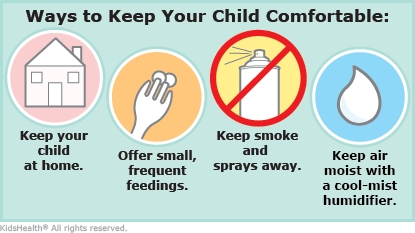Whooping Cough (Pertussis): How to Care for Your Child
Whooping cough (pertussis) is a contagious illness caused by bacteria. Most kids get better with treatment, although a mild cough may continue for several weeks.


A child with pertussis starts out with symptoms of a common cold and later develops coughing spells that come and go. These spells can be severe, lasting more than a minute and sometimes ending in a "whooping" sound when the person breathes in. Some people throw up at the end of a coughing spell. Sometimes kids with pertussis cough so hard that red spots from broken blood vessels happen in one or both eyes. A child usually feels well between spells.
Treatment with antibiotics reduces the chance of other problems related to a pertussis infection and helps keep your child from spreading the illness to other people. It takes 5 days on antibiotics before a child is no longer contagious. Even after the infection is gone (usually after 3 weeks), coughing may continue for several weeks, but should steadily improve.
The health care provider talked to you and your child and did an examination. Health care providers often can diagnose pertussis this way, but sometimes tests are done to help confirm that a child has pertussis. The tests might include a sample of mucus from the back of the nose, blood tests, or a chest X-ray.
The results of all of these tests might not be ready today, but the health care provider has enough information to suspect your child has pertussis. Most kids with pertussis do not need to stay in the hospital. Your child is doing well and can be safely cared for at home.

-
Give the prescribed antibiotics to your child as directed.
-
Your child should stay home until the health care provider says it's OK.
-
Cough medicines don't help kids with pertussis and may make it harder to cough out mucus from the airway. Don't use them without asking your health care provider first.
-
Give your child plenty of fluids to drink.
-
If your child is throwing up, offer small, frequent meals.
-
Using a cool-mist humidifier in your child's bedroom might make your child more comfortable. Clean the humidifier every day to prevent mold growth.
-
Keep your home free of irritants, such as smoke and aerosol sprays, that can trigger coughing spells.

-
Schedule any follow-up appointments as directed.
-
Make sure your family's pertussis vaccinations are up to date.
-
Remind your family to prevent the spread of infection by washing hands often and covering mouths when coughing.
-
Whooping cough is very contagious. Members of your household and other people that your child spends time with (such as kids and teachers at childcare or school) should visit the health care provider for possible antibiotic treatment to prevent them from getting sick, and for testing if they are already sick.

Your child:
-
Continues to cough frequently.
-
Has trouble eating or drinking.
-
Has chest pain.
-
Develops a new fever.
-
Has a severe headache or is very fussy.

Your child:
-
Has trouble breathing or seems to have brief periods of not breathing.
-
Is pale or bluish around the mouth or fingernails.
-
Appears dehydrated; signs include dizziness, drowsiness, a dry or sticky mouth, sunken eyes, crying with few or no tears, or peeing less often (or having fewer wet diapers).
-
Has a seizure.